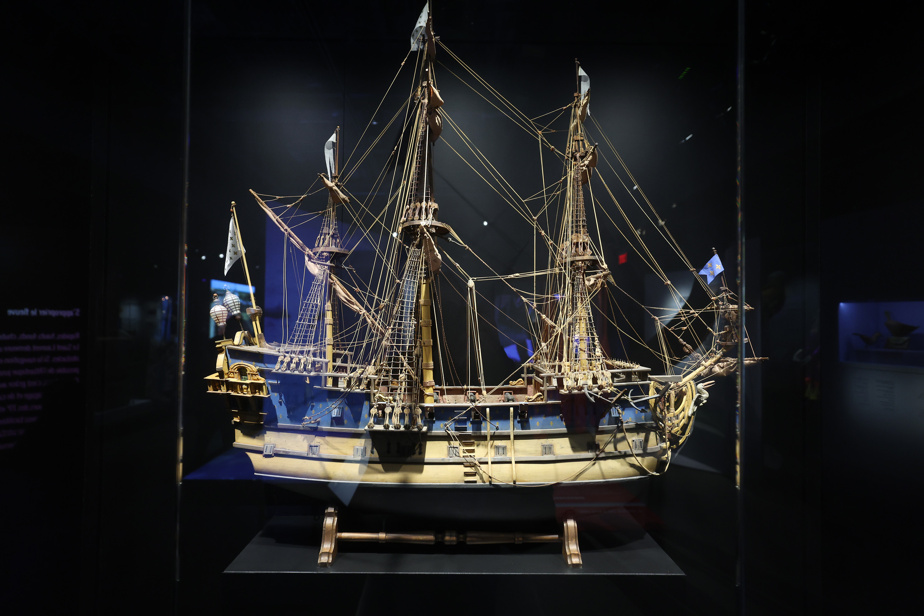You will know everything about the St. Lawrence River, its wealth, its wrecks and its battles, thanks to the exhibition presented until March 3, 2024 at the Pointe-à-Callière museum, entitled Saint Lawrence River, echoes from the shores.
Did you know that the basking shark, the second largest fish in the world, frequents the waters of the St. Lawrence? That scientists estimate the number of plant and animal species present in the St. Lawrence at around 27,000? That the National Assembly of Quebec designated the St. Lawrence as national heritage in 2010? This is what you will discover by going to see the exhibition Saint Lawrence River, echoes from the shoreswhere we are presented with the river in all its splendor and from all angles.

PHOTO MARTIN CHAMBERLAND, THE PRESS
The St. Lawrence River, Echoes of the Shores exhibition at Pointe-à-Callière presents more than 300 objects from the Quebec Maritime Museum and the Musée de la civilization.
Along the route, we discover the immensity of the river according to different themes: fishing, river transport, shipbuilding, wrecks, battles, tourism, biodiversity and environmental issues. The exhibition aims to be “multisensory”; there are interactive maps, projections and film clips, exhibits, smells and sounds, which make the journey very alive.
“Our relationship with the river is different depending on the city where we live. In Montreal, we are an island in the middle of the Saint-Laurent, we are 2 million islanders, but we have controlled the river, we have built bridges, canals, locks, we have lost a little of given the more natural side of the river, it no longer has any influence on us whereas if you live in the Îles-de-la-Madeleine, the river (the Gulf of Saint-Lauent) is very present on a daily basis with its tides and its ferries,” analyzes Samuel Moreau, Exhibitions-Multimedia Technologies project manager at the Pointe-à-Callière museum.
The power of the river
One of the most impressive parts of the exhibition is the one on shipwrecks. We understand better to what extent the St. Lawrence is one of the most difficult rivers to navigate in the world. The tides are impressive, and currents can reach speeds of 5.9 knots (11 km/h) in some areas.
Many sailors lost their lives there, and the shipwreck that left its mark was that of theEmpress of Ireland on May 29, 1914. This Canadian Pacific transatlantic liner collided with the Norwegian coal ship Storstad, off the coast of Rimouski. In 14 minutes, the liner sank, leaving only 465 survivors out of the 1,489 people on board.
“The wreck is located in the river off Pointe-au-Père, it is protected, classified as a heritage object, we can no longer access it,” explains Samuel Moreau.

PHOTO MARTIN CHAMBERLAND, THE PRESS
Samuel Moreau, Exhibitions-Technologies-multimedia project manager at the Pointe-à-Callière museum
Certain objects [de l’Empress of Ireland] are on display here, like the plates from the three different classes and there is this leg of the grand piano from the first class music room. We can see it in the archive photo and it shows us life on board the liner.
Samuel Moreau, Exhibitions-Multimedia Technologies project manager at the Pointe-à-Callière museum
He specifies that the river is full of dangers with its reefs and currents, and even today, it is obligatory for all ships entering the St. Lawrence to use trained pilots.
“All the ships stop at Les Escoumins, a pilot comes on board, and takes them to their safe port. There are pilots who specialize in three different maritime sections of the river, Escoumins-Québec, Québec–Trois-Rivières, and Trois-Rivières–Montréal,” he says.

PHOTO MARTIN CHAMBERLAND, THE PRESS
Objects from the liner Empress of Irelandplates from the three classes and the foot of the grand piano from the music room.
A little history
Throughout the exhibition, we are reminded that the St. Lawrence River is an essential trade route, that the Seaway opened in 1959 and became the largest route of maritime penetration on all continents. “Maritime transport on the St. Lawrence is very important for the economy, it represents 45% of Canada’s international traffic,” explains Samuel Moreau.
Let’s not forget that the St. Lawrence is one of the longest rivers in Canada.
The watershed of the St. Lawrence River, which includes the Great Lakes which flow into the river, represents 25% of the planet’s fresh water reserves!
Samuel Moreau, Exhibitions-Multimedia Technologies project manager at the Pointe-à-Callière museum
“We are in Quebec, but we do not realize that Ontario, with part of the United States, is more than 20 million people who live in the watershed of the St. Lawrence River which reaches a length of 3,260 km,” explains Samuel Moreau.

PHOTO MARTIN CHAMBERLAND, THE PRESS
In 1913, Canada Steamship Lines organized luxurious cruises on the river with the “white boats”.
The river is the tourism that was developed on the banks of the St. Lawrence with the launch of the first steamboat in 1809, then in 1913, the Canada Steamship Lines organized luxurious cruises with the “white boats » which accommodate up to 500 passengers. Bas-du-Fleuve became a very popular vacation spot; people frequented the Tadoussac hotel and the Manoir Richelieu in Charlevoix.
The river is also a source of pleasure. We enjoy the fish, lobsters and other shellfish, we can observe the humpback whale and the beluga. We are reminded at the end of the exhibition that the river is a fragile heritage that must be protected, and that it is necessary to continue efforts to safeguard it.
The exhibition Saint Lawrence River, echoes from the shores is on display at the Pointe-à-Callière museum until March 3, 2024.
